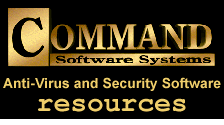
|
Home Page
|
F-PROT Professional for DOS Command Line SwitchesUse command line switches when you wish to run F-PROT in a non-interactive mode. A good example is having your AUTOEXEC.BAT run a scan each time you boot your computer.SWITCH: Description /640: Scan only the first 640K of memory. Some video drivers require this. /ACCESS: Prevents the last access date from changing on a Novell file server. This maintains compatibility with archival software that relies on access dates. /ALL: Search all files, not just executables. This approach may cause false positives and should be used with care. /ANALYZE: Perform a heuristic analysis instead of a signature-based scan. This approach may cause false-positives, and should be used with care. /APPEND: Append a new record to an existing one. Use this with the /REPORT switch. /ARCHIVE: Search within .ZIP files. Note that PKUNZIP must be within a PATHed directory. There must be a TEMP environment established by your AUTOEXEC.BAT. SET TEMP=C:\TEMP /AUTO: Use with /DELETE or /DISINF switches so F-PROT Professional for Windows will not prompt you before deleting or disinfecting a file. By default /DELETE and /DISINF ask if the file should be deleted or disinfected. /BEEP: Sound an alarm when a virus is found. /BOOT: Scan for MBR and boot sector viruses. This is the default. /COMMAND: Force command-line mode. This switch won't display any of the F-PROT Professional for Windows menus. /DELETE: Delete all infected files, instead of listing them. /DISINF: Disinfect whenever possible. It will never delete a file that can be disinfected. However, this option does delete first-generation virus samples. A first-generation virus is the "starter" program that begins the infection process. It is rare to encounter one. /EXT: Specify additional filename extensions to scan. Separate each filename extension with a . (period) For example: /EXT=EXE.COM.PRG.DBL. /FILE: Scan for file viruses. This is the default. /FREEZE: Halt the computer when a virus is found. /HARD: Scan all of the physical hard disks in the system. /HELP or /?: Display a list of available options. /INTER: Force interactive mode. /LIST: Produce a report of all files checked, not just those which are infected. /MONO: Force monochrome screen mode. This is useful with some laptops. /MULTI: Prompts for multiple diskettes to scan. /NET: Scans all network drives. /NOBOOT: Do not scan for MBR or boot sector viruses. /NOBREAK: Do not allow the user to press [ESC] key to abort a scan. /NODOC: Excludes all document files from the scan. /NOFILE: Do not scan for file viruses. /NOMEM: Do not scan memory. /NOPACKED: Do not search inside packed files. /NOSUB: Do not scan sub-directories. /NOUSER: Do not search for user-defined virus patterns. This is the default. /NOWRAP: Do not wrap text in reports. /OLD: Do not display out of date warning that occurs after 90 days. /PACKED: Search inside packed files. This is the default. /PAGE: Pause after every screen when displaying information in command-line mode. /RENAME: Rename infected files. You may use this switch with /AUTO. /REPORT: Sends the output to the specified file, in addition to displaying it on the screen. For example, /REPORT=virus.txt /SILENT: Generates no screen output at all. This is useful when running the program from a batch file where you will check for the return code. /TODAY: The date of the last scan is stored in an F-PROT.DAT file. If the next scan finds the same date, F-PROT returns an errorlevel 99 and aborts the scan.
/USER: Search for user-defined virus patterns. This option should only be
used if absolutely necessary, as it can result in a considerable speed decrease.
This is a sample command line that would be placed as one of the first few lines in an AUTOEXEC.BAT file. The goal is to perform a daily, full scan before logging onto a network or loading any TSR programs.
At this point, you should turn the machine off, insert the Emergency Boot Disk described in Appendix A, turn the system back on and disinfect it.
|
|